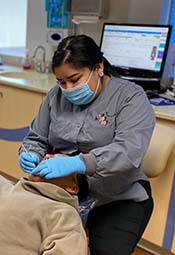If you are considering braces vs Invisalign to straighten your teeth, or your kid’s teeth, you may have lots of questions. Which is more effective? Which is more affordable? Ultimately, you want to choose the treatment that will do the job, even if it’s slightly more expensive. In the long run, you don’t want to have to fix your teeth again! So, are braces or Invisalign the better choice for you or your kid?
Braces vs Invisalign: Getting Straight to the Basics
Both braces and Invisalign were designed to straighten teeth while improving your smile and oral health. Customers first began using Invisalign in 2000, so this treatment does not yet have the same history as braces.
Braces consist of metal brackets being glued to your teeth and tied together by wires and tiny rubber bands. Nowadays, you can get brackets to more closely match your enamel color (making them more discrete), or you can get them in color to make a fashion statement with your mouth!
Invisalign, on the other hand, is designed to be invisible. Aligner trays made of smooth, comfortable, BPA-free clear plastic are worn over your teeth to subtly and gently move your teeth. Your specialist will use X-rays, pictures, and impressions to create a precise 3-D image of your teeth and to configure your aligner trays accordingly.
Braces vs Invisalign, Which Will Work Best for You?
While both braces and Invisalign can help straighten teeth, they each have pros and cons.
Take a look at the detailed braces vs Invisalign comparison chart below.
| Braces (irremovable) | vs | Invisalign (removable) |
| Metal-typically silver; can pay extra for color or enamel color | Color | Clear/invisible |
| 24/7 for an average of 2 years, depending on patient needs | Treatment time | 22-24 hrs/day for 6 to 18 months, depending on patient needs |
| $1,800-$5,500 | Cost | Average of $5,000 |
| Brush brackets and wires regularly while brushing teeth; water pick may be helpful. | Maintenance | Invisalign Cleaning system, or brushing and rinsing trays in luke warm water |
| About every month | Follow up visits | Change aligner trays every 2 weeks; visits every 4 to 6 weeks |
| Positioner or retainer likely needed ongoing, maybe only at night | Follow up to treatment | Positioner or retainer likely needed ongoing, maybe only at night |
|
Pros |
|
|
Cons |
|
| Patients playing rough contact sports regularly | NOT ideal for |
Patients with:
|
How Does Invisalign Work?
Clearly, in comparing braces vs Invisalign, it’s a tight race. If you’re an adult or have a teen, who tends to be self-conscious, Invisalign may appeal to you. And the fact that it’s removable so you can eat, drink, brush and floss more naturally, may sound desirable. But if the idea of having to remove your trays for meals or while drinking anything but water seems inconvenient, Invisalign may not be the best solution for you. Plus remember, you should brush after each meal before putting your trays back in, to avoid staining.
Exact success rates for braces vs Invisalign are difficult to find, especially since Invisalign has not been around long enough to gather long-term data. Plus, Invisalign’s success depends almost entirely on the beholder. If you don’t wear them, they won’t work. With braces, you don’t have any choice in the matter!
Lastly, if you need to address issues with your back teeth, need to rotate teeth or move teeth vertically, Invisalign may not even be an option. That’s why it’s critical to enlist a provider like MyOrthodontist, experienced with both braces and Invisalign. Then your orthodontist can recommend the most effective solution to perfect your smile and teeth.
Straightening your teeth to improve your smile and overall oral health should not be taken lightly. If you need help deciding whether braces or Invisalign makes more sense for you or your child, consult an experienced specialist like MyOrthodontist today!


